The time came when after a couple of months of sampling I have to take a breath and reflect on what I have produced. These were the months of exploration and experimentation. During this time I produced a lot of work. Not all of it was good, but there are some good aspects. Let’s review my creative journey by analysing my favourite and most successful samples.
I have used viewfinders of different sizes to evaluate my samples and choose sections where I worked well considering texture, composition, scale , technique. Afterwards I supported the information sketching, collaging. With all this I am trying to resume and clarify the direction of my creative process and choose an arena where my textiles could fit in.

These are my most successful samples. I have described them in three words: TACTILE, COMPLEX and TEXTURED.
In all my samples I was trying hard to have the balance of weight, use different materials and techniques, they all are collages and complex structures. Working this way I believe I can best reveal my potential. Even tho not all samples are connected with the same theme, I believe they all have similar properties, as my personal signature.
Let’s talk about them one by one.
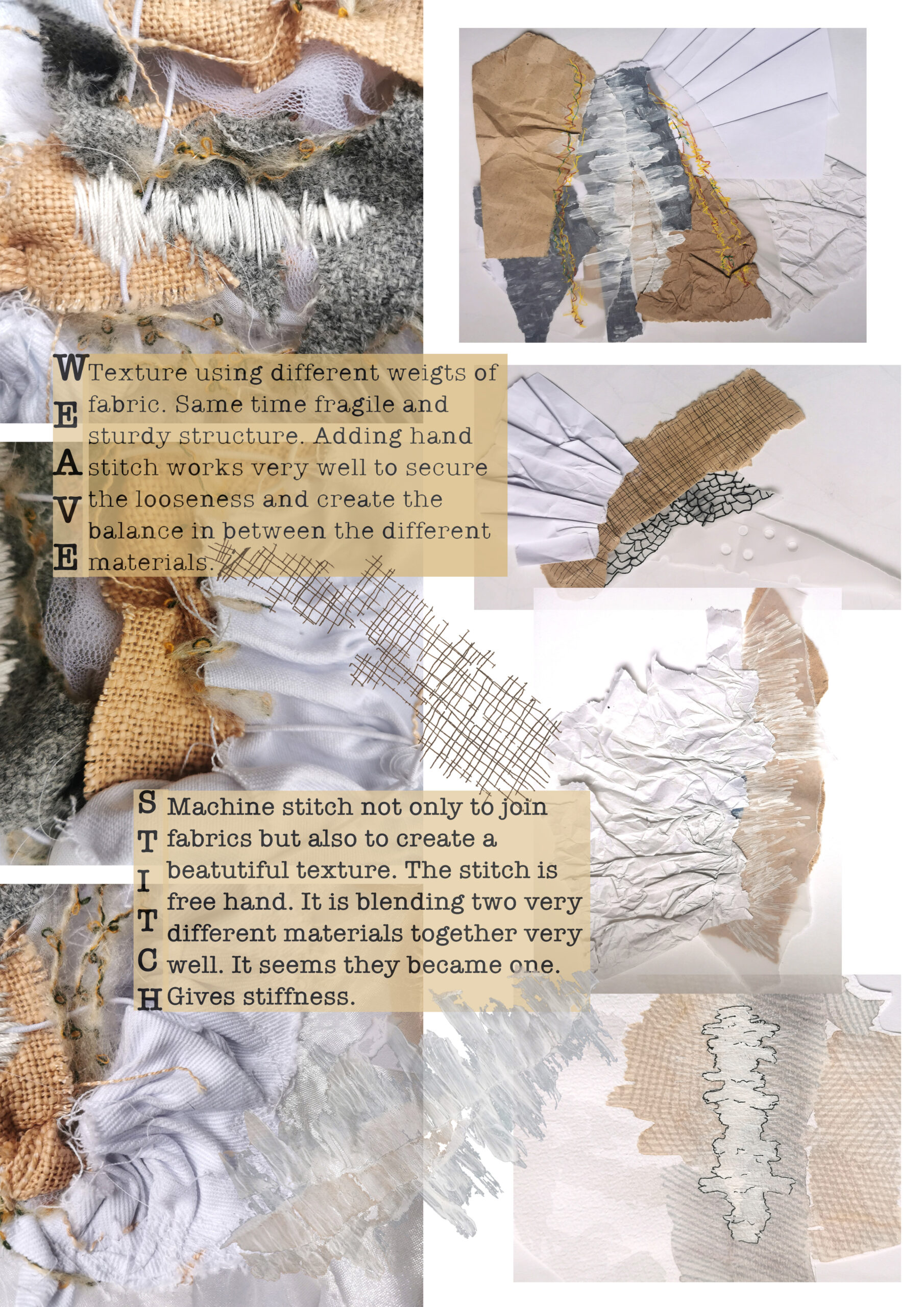 This section of my sample in my eyes is very successful. I really like how expressive it is. I weaved different scraps of fabric on an elastic string. I made sure that fabrics differ in weight and texture. Considering that fabrics are constructed on elastic, the formation is pretty fragile. Therefore I secured the structure using hand and machine stitch. Machine stitch is free hand and forced, random. I realised that this way of using the stitch not only joins the fabrics together but also gives texture, blends materials together and gives aesthetic value. Responding to my thoughts about these sections of the sample I made few collages, using different papers, while choosing paper I was looking into representing the texture of each different fabric.
This section of my sample in my eyes is very successful. I really like how expressive it is. I weaved different scraps of fabric on an elastic string. I made sure that fabrics differ in weight and texture. Considering that fabrics are constructed on elastic, the formation is pretty fragile. Therefore I secured the structure using hand and machine stitch. Machine stitch is free hand and forced, random. I realised that this way of using the stitch not only joins the fabrics together but also gives texture, blends materials together and gives aesthetic value. Responding to my thoughts about these sections of the sample I made few collages, using different papers, while choosing paper I was looking into representing the texture of each different fabric.
I doubt I will use weave in my developed samples, but certainly take forward the stitch work and similar consideration in choosing fabrics.
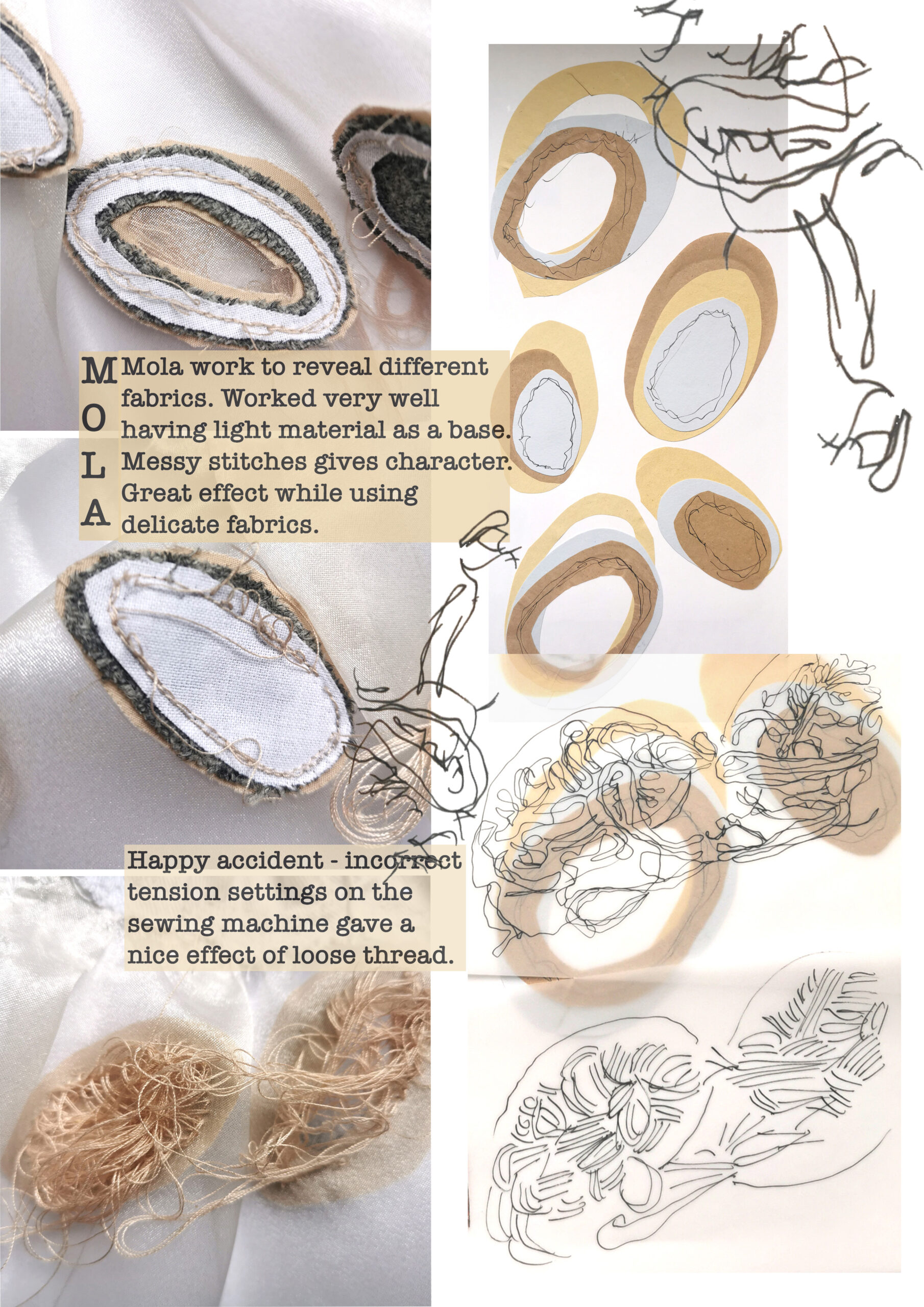
Same sample, different section. Mola work work did a great job revealing all different fabrics. I really like working with light, see through materials. It gives me opportunities of layering, I like the tactile feel of them. Mola work proved to be great, when wanting to keep light material as a base, yet adding details with heavier fabrics. Using this technique, the light weight fabric is not damaged by stitch or tension.
Here I am also using messy stitching, which gives, originally a tidy the piece, some character. As mentioned in my previous blog posts – this happened by a complete accident, incorrectly setting tension on the sewing machine. This effect could be taken forward. Again, creating textures with thread and stitches. In my drawings, I was doing line work, different strokes, to imitate different stitches and thread wraps.
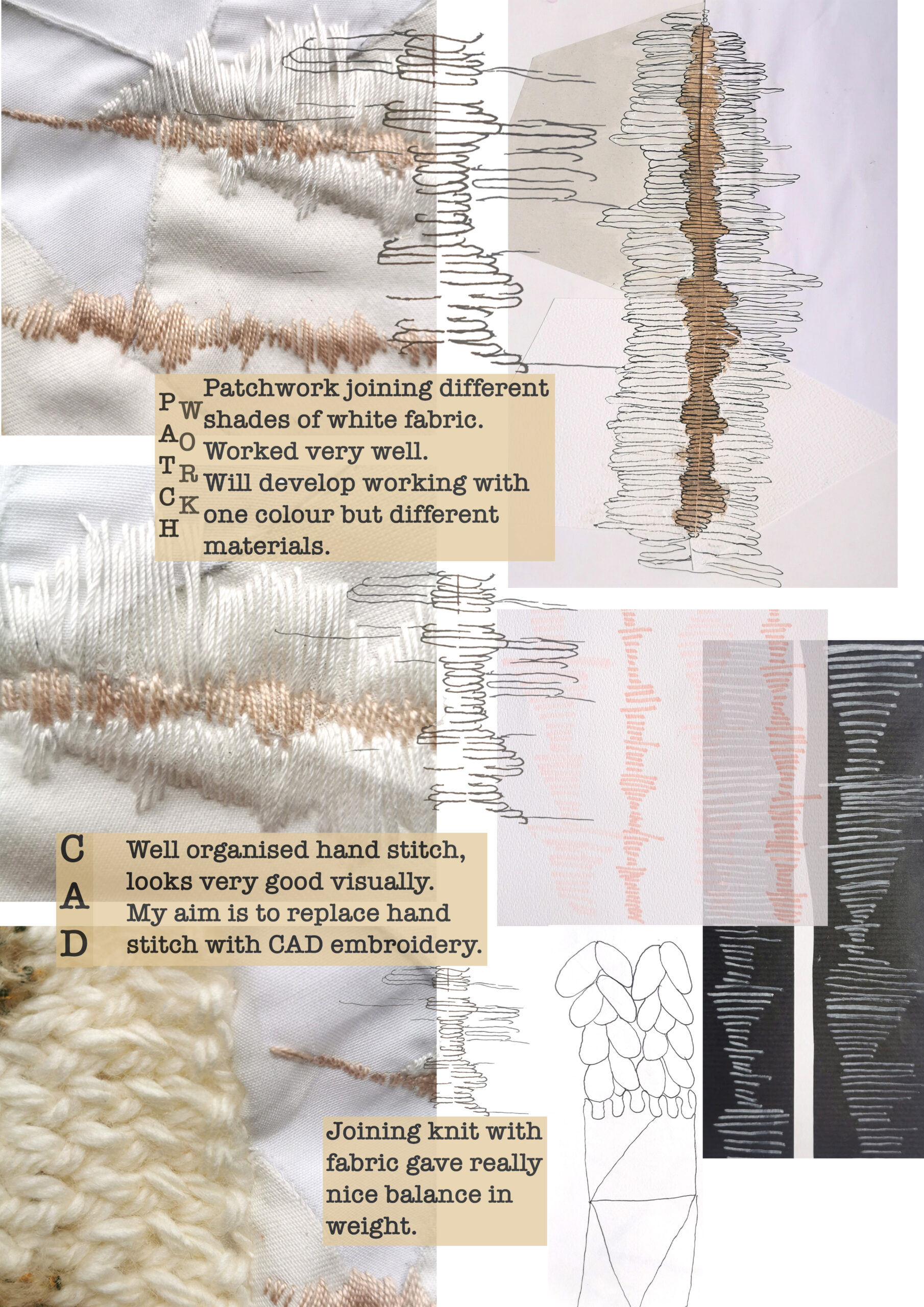 Here I liked working with same colour but different materials. All materials had slightly different shade and of course texture. Patchwork helped to structure the fabrics.
Here I liked working with same colour but different materials. All materials had slightly different shade and of course texture. Patchwork helped to structure the fabrics.
Hand embroidery works well here as well, but while working on this piece I was considering the CAD embroidery. I think it would work very efficiently here. That is what I will work with on my developed samples. My way of working is quite clean and I do not embellish heavily, therefore CAD embroidery would be a good way, to use embroidery for structure and texture.
Lastly, here I was joining the patchwork with knit, which worked amazing to represent balance, as well as considerate junction of techniques
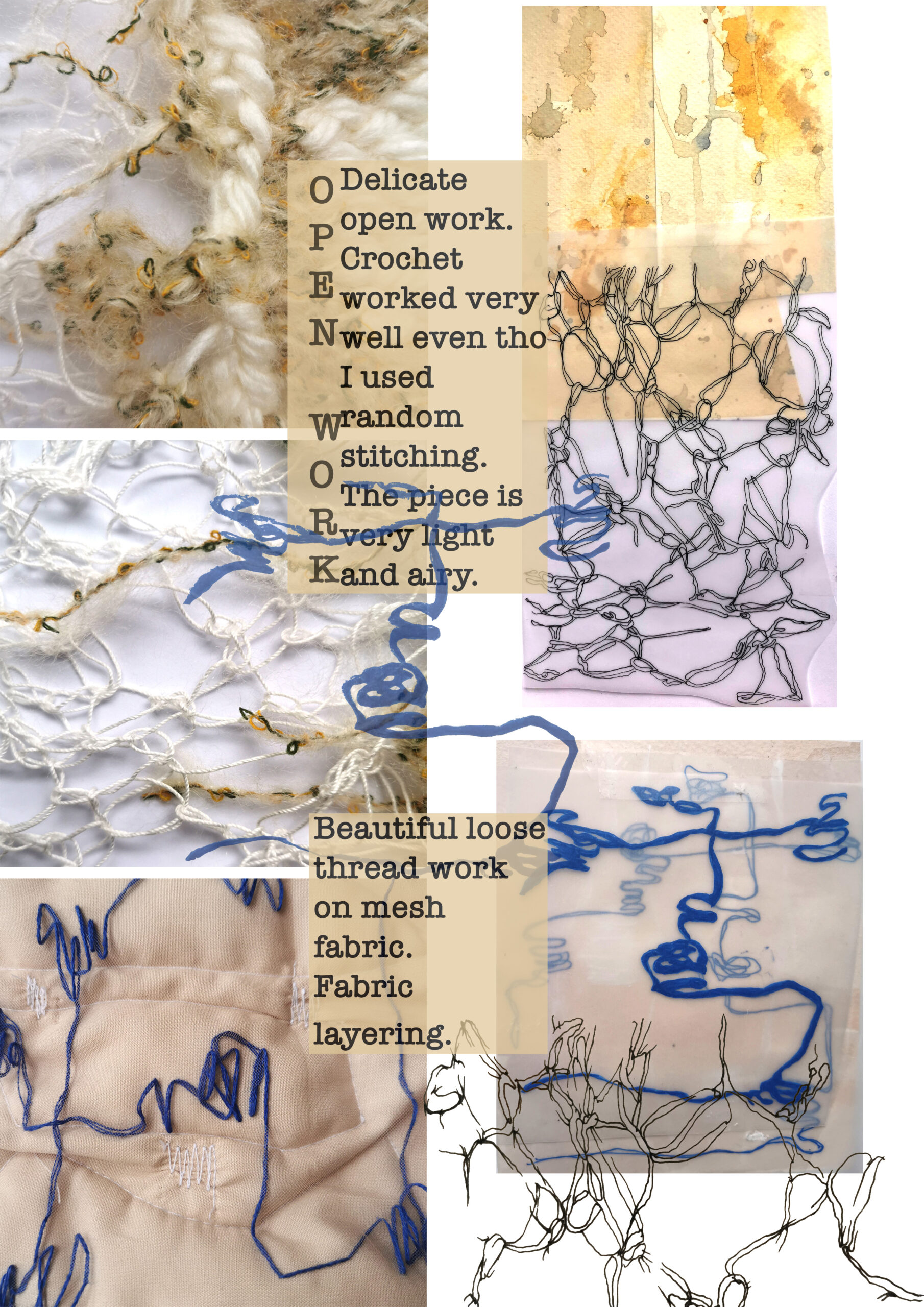
I personally love this open work. I did crochet with not much consideration on getting the stitches right, I mixed all different ones in random order. Yet the piece looks far from messy. It is really light and airy. I am considering to develop this section, but using more unconventional materials. This sort of piece would incorporate well with heavier ones, fabric patch work for example.
The second sample here is analysed only a little, but I couldn’t leave it behind. I really like the thread work on a transparent fabric. This way both sides of thread work are visible. Great adding details, layering.
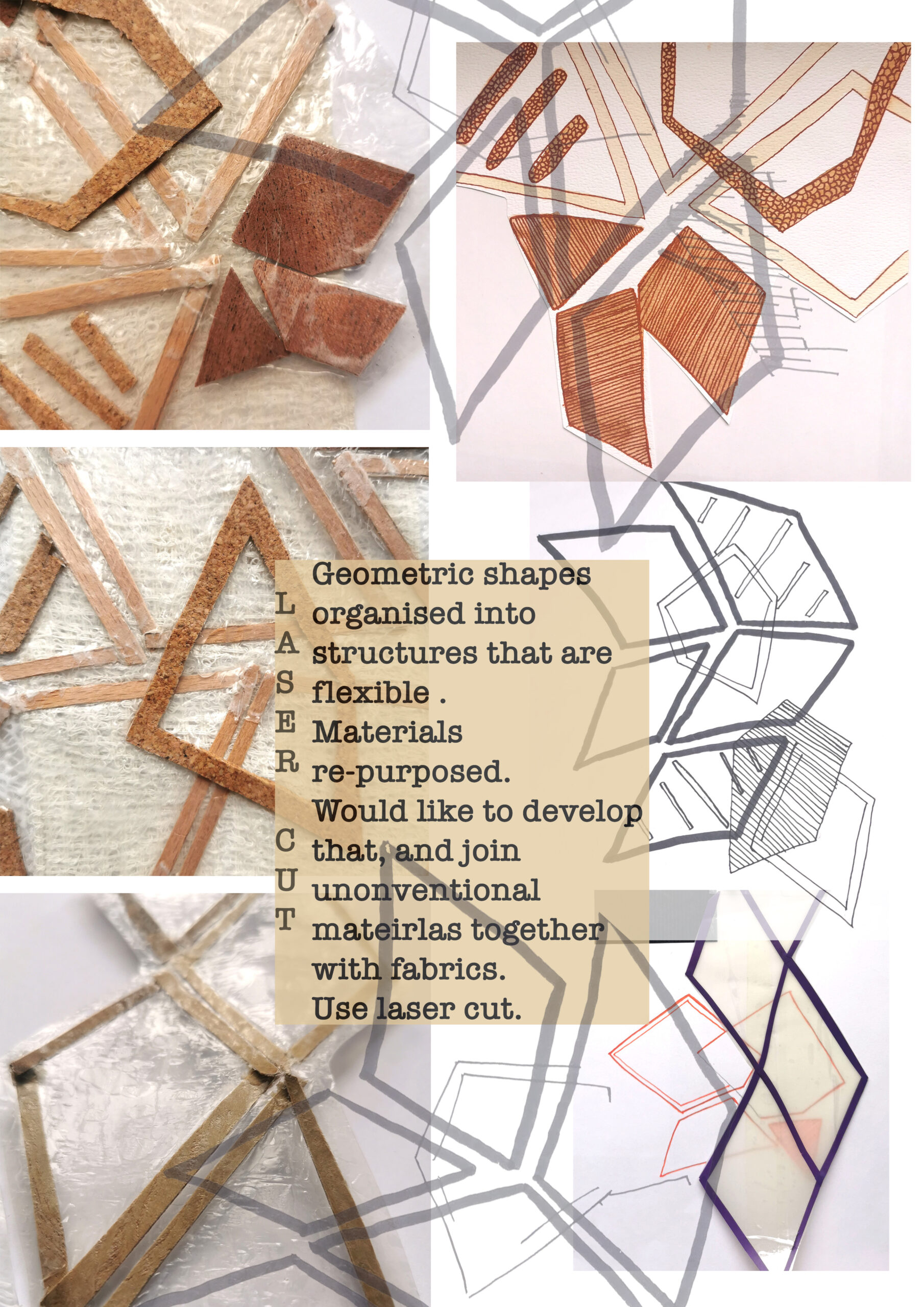 I really enjoyed re-purposing the materials. Here, the sturdy materials such as wood or cork, cut in pieces and organised the way that they in fact transform to be flexible. All depending on the shapes and their organisation. While working on this project I was thinking a lot on working with laser cut and how many possibilities that would give me.
I really enjoyed re-purposing the materials. Here, the sturdy materials such as wood or cork, cut in pieces and organised the way that they in fact transform to be flexible. All depending on the shapes and their organisation. While working on this project I was thinking a lot on working with laser cut and how many possibilities that would give me.

Similar story here. I am usually not used to work with geometric shapes, but here they serve for the purpose of different textures and structures. Here I responded with some collage work, drawings of different placements of shapes.
As well as here I heat transfer printed on medical bandage. That makes me think of sublimation printing for my developed samples.
 Lovely textures and skin like feel, using microbial cellulose. I was using this material fusing to others with heat. Heat made the cellulose even more textured, made it change colour. These sections of my sample are giving me ideas of the theme I will be concentrating on for my third project.
Lovely textures and skin like feel, using microbial cellulose. I was using this material fusing to others with heat. Heat made the cellulose even more textured, made it change colour. These sections of my sample are giving me ideas of the theme I will be concentrating on for my third project.
During the second project I was working around mimicking animal skin, its structure and textures. After experimenting with microbial cellulose, discovering the surface textures it can give and considering that it is a completely natural material, I research more in depth about natural surfaces. Moreover, this material is sustainable, biodegradable, accessible to everyone to grow at home with using only few simple ingredients. Project 3 will be also concentrated on sustainability – the biggest design challenge in textiles and fashion industries.
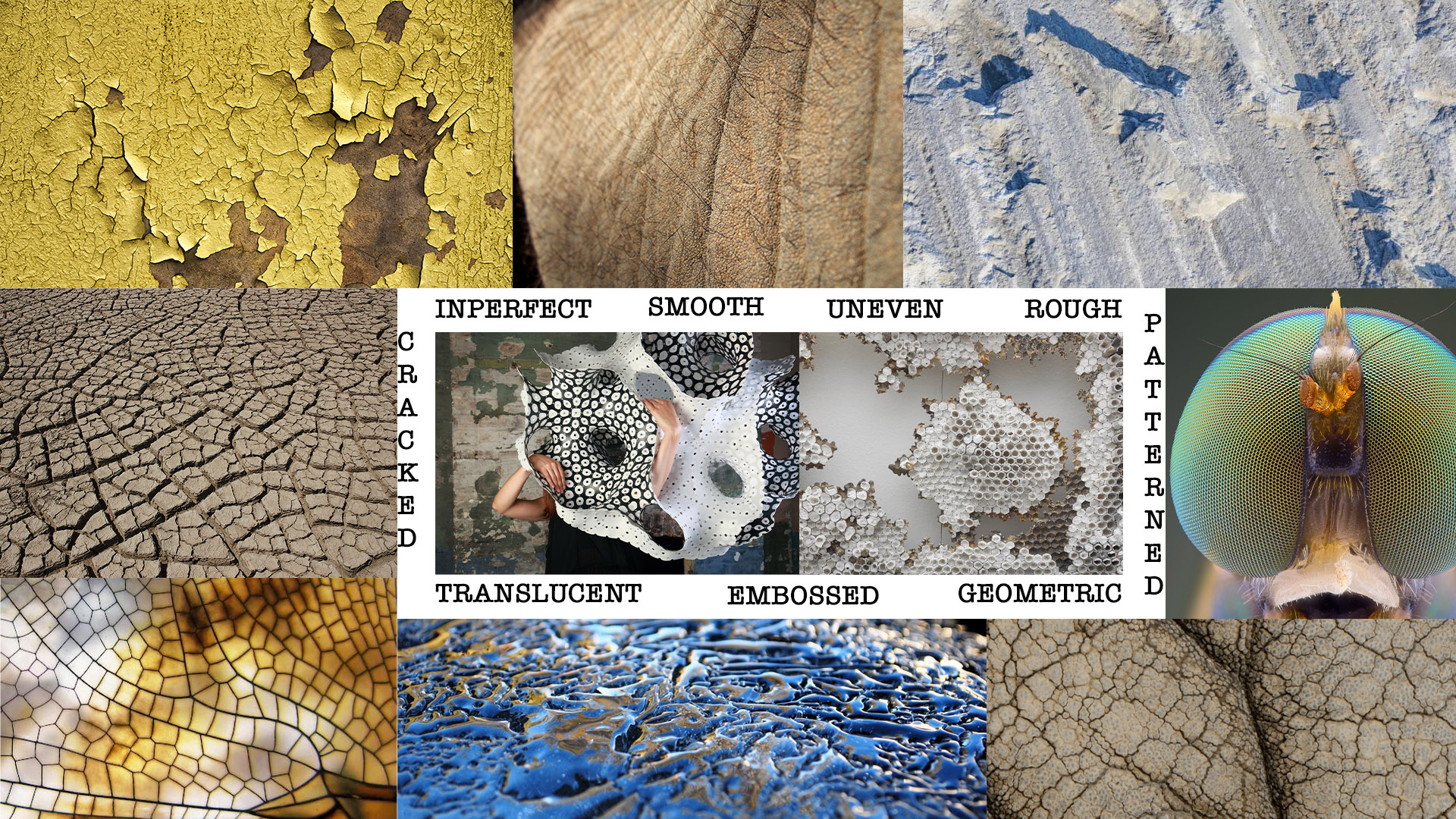 I have looked into natural surfaces for more inspiration and extracted few key words to direct my ideas. There is so much information that I could take forward. I began to wonder that the project 3 will be more about structured textiles rather than heavily embellished. I will use embellishment techniques really considerate in order to serve the purpose of improving the key properties of my samples PURPOSE – TEXTURE – STRUCTURE.
I have looked into natural surfaces for more inspiration and extracted few key words to direct my ideas. There is so much information that I could take forward. I began to wonder that the project 3 will be more about structured textiles rather than heavily embellished. I will use embellishment techniques really considerate in order to serve the purpose of improving the key properties of my samples PURPOSE – TEXTURE – STRUCTURE.
In project two I worked around mimicking animal skin, mainly fish and reptile. After researching natural surfaces and having the textures of microbial cellulose in mind I started thinking about human’s skin. Human’s skin has so many surface textures. Its properties are either genetic, affected by time, external influences, temperature, environment.
 Textile can be considered as our second skin – a layer to protect, give sensation, control heat, repel water, communicate and have aesthetic properties.
Textile can be considered as our second skin – a layer to protect, give sensation, control heat, repel water, communicate and have aesthetic properties.
Can I create a fabric to communicate all that and as well to reflect the different skin textures?
My textile work was always directed towards fashion. Therefore the next step was to research fashion trends, forecasts.

My work can be applicable in few sections of the new upcoming trends. The designs for next year are comfortable and comforting, purposeful and functional. I can apply many techniques that I have learned or practiced so far and include some new ones. Will be designing woman’s apparel.
As mentioned before, my design will be concentrated on STRUCTURE rather than embellishment, RE-CONSTRUCTION of materials and RE-PURPOSING. Embellishing techniques such as embroidery will be used to improve texture and architecture of the fabric. Design will be RESPONSIBLE, MINDFUL and SUSTAINABLE. Will be practicing techniques such as patchwork, CAD embroidery, stitch, will try to get familiarised with laser cut. May include knit and crochet.
Lastly, the samples I produced in project 3 will be my entry to the Bradford Textile Society Design Competition. Considering the nature of my work I am in between these three categories:

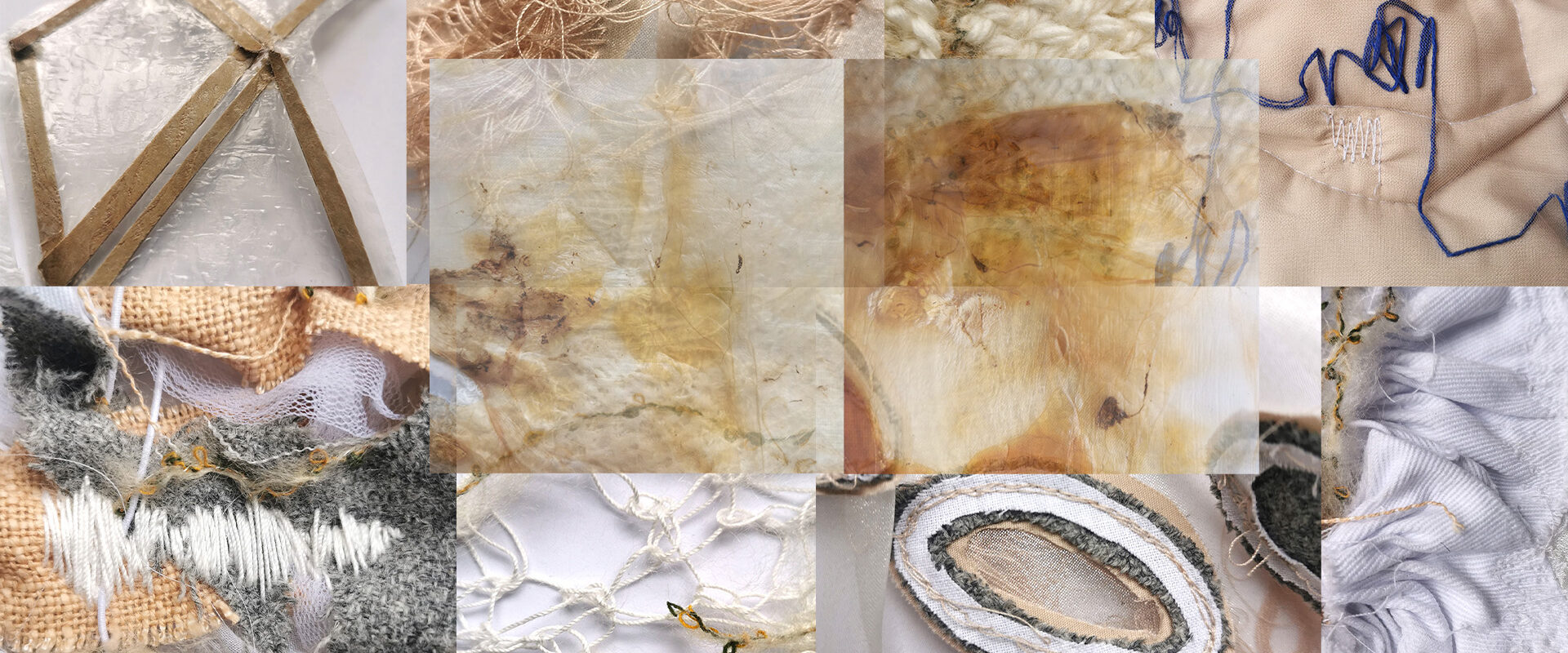



Really insightful Ruta, you are analysing your own design process really well and the samples you have created are explorative and expressive – well done! Your blog is eye catching with the balance of informative and creative visuals and text to support your thinking!
Maija (project 3 tutor)
Excellent analysis here. This now needs editing to clarify direction convincingly achievable within the timescale. There are SO many wonderful possibilities to choose from, however this needs to be fitted within yoru timescale. Do avoid over working this and riasing expectations to unachievable heights. Remember you can only show 1 main sample plus supporting samples.